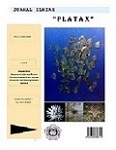Fly fish growth pattern (Decapterus spp) in Likupang Water, Nort Sulawesi
DOI:
https://doi.org/10.35800/jip.7.1.2019.22593Abstract
This study was aimed to find out the size distribution of scad (Decapterus spp) caught by Likupang fishermen and to find out theirgrowth patterns. Fish samples were collected by traditional purse seine fishermen in Likupang waters. Total catches were 139 individuals consisting of 89 D. macarellus and 50 D. macrosoma.The former was dominated by size of 19.2-20.6 cm, while the latter was dominated by size of 13.1-14.1 cm. Length-weight relationship analysis showed that the growth patterns of D. macarellus and D. Macrosoma were isometric meaning that the increase in length is consistent with weight gain.
Keywords: Likupang, Decapterus spp and growth patterns
ABSTRAK
Penelitian ini bertujuan untuk mengetahui distribusi ukuran ikan layang (Decapterus spp) yang ditangkap oleh nelayan Likupang and untuk menduga pola pertumbuhannya. Sampel ikan diperoleh nelayan tradisional pukat cincin di perairan Likupang.Total hasil tangkapan adalah 139 ekor terdiri dari 89 ekor D. macarellus dan 50 D. macrosoma. Hasil tangkapan D. macarellus didominasi oleh kelas ukuran 19,2-20,6 cm, sedangkan D. macrosomadidominasi oleh kelas ukuran 13,1-14,1 cm. Analisis hubungan panjang berat menunjukkan bahwa pola pertumbuhan ikan D. macarellusdan D. macrosoma bersifat isometrik yang artinya pertambahan panjang selaras dengan pertambahan berat.
Kata kunci: Likupang, Decapterus spp dan Pola pertumbuhanDownloads
Published
How to Cite
Issue
Section
License
COPYRIGHT
Authors who publish with this journal agree to the following terms:
Authors hold their copyright and grant this journal the privilege of first publication, with the work simultaneously licensed under a Creative Commons Attribution License that permits others to impart the work with an acknowledgment of the work's origin and initial publication by this journal.
Authors can enter into separate or additional contractual arrangements for the non-exclusive distribution of the journal's published version of the work (for example, post it to an institutional repository or publish it in a book), with an acknowledgment of its underlying publication in this journal.
Authors are permitted and encouraged to post their work online (for example, in institutional repositories or on their website) as it can lead to productive exchanges, as well as earlier and greater citation of the published work (See The Effect of Open Access).




















